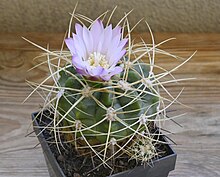Gymnocalycium monvillei
| Gymnocalycium monvillei | |
|---|---|

| |
| Scientific classification | |
| Kingdom: | Plantae |
| Clade: | Tracheophytes |
| Clade: | Angiosperms |
| Clade: | Eudicots |
| Order: | Caryophyllales |
| Family: | Cactaceae |
| Subfamily: | Cactoideae |
| Genus: | Gymnocalycium |
| Species: | G. monvillei
|
| Binomial name | |
| Gymnocalycium monvillei (Lem.) Pfeiff. ex Britton & Rose 1922
| |
| Synonyms | |
| |
Gymnocalycium monvillei is a species of Gymnocalycium from Argentina.[2]
Description
[edit]Gymnocalycium monvillei grows individually, rarely sprouting, with dark green, spherical to flattened spherical shoots, which reach heights of 6 to 8 centimeters with diameters of up to 20 centimeters and form a massive taproot. As plants age, they sometimes become short, columnar. The 10 to 17 wide, blunt ribs are clearly divided into humps with conspicuous chin-like projections. The areoles are oval and, in addition to the thorns, have a dirty-whitish wool felt. The strong, thick, slightly curved thorns are yellowish and have a reddish or purple base. There are one to four central spines up to 6 centimeters long, which can sometimes be missing. The 7 to 13 marginal spines are 3 to 4 centimeters long.
The white, red-tinged, partially monoecious flowers reach a length of 3 to 8 centimeters and a diameter of 4 to 9 centimeters. The stamens are whitish with yellowish pollen, the style is whitish yellow. The spherical fruits are green to cloudy orange-red and reach a diameter of up to 2 centimeters.[3]

Subspecies
[edit]- Gymnocalycium monvillei subsp. achirasense (H.Till & Schatzl) H.Till
- Gymnocalycium monvillei subsp. horridispinum (G.Frank ex H.Till) H.Till
- Gymnocalycium monvillei subsp. monvillei
Distribution
[edit]Gymnocalycium monvillei is distributed in central and northern Argentina, in the provinces of Córdoba and San Luis at altitudes of 500 to 2700 m.
Taxonomy
[edit]The first description as Echinocactus monvillii was made in 1838 by Charles Lemaire.[4] The specific epithet monvillei honors the plant collector Hippolyte Boissel de Monville. Nathaniel Lord Britton and Joseph Nelson Rose placed the species in the genus Gymnocalycium in 1922.[5]
References
[edit]- ^ "The IUCN Red List of Threatened Species". IUCN Red List of Threatened Species. 2010-09-20. Retrieved 2023-12-08.
- ^ "Gymnocalycium monvillei in Tropicos".
- ^ Anderson, Edward F.; Eggli, Urs (2005). Das grosse Kakteen-Lexikon (in German). Stuttgart (Hohenheim): Ulmer. p. 320. ISBN 3-8001-4573-1.
- ^ Lemaire, C.A. (1838). Cactearum aliquot novarum ac insuetarum in horto Monvilliano cultarum accurata descriptio: fasc. 1 (in Latin). Apud F. G. Levrault. p. 14. Retrieved 2023-12-09.
- ^ Britton, Nathaniel Lord; Eaton, Mary E.; Rose, J. N.; Wood, Helen Adelaide (1919). The Cactaceae : descriptions and illustrations of plants of the cactus family. Washington: Carnegie Institution of Washington. doi:10.5962/bhl.title.46288.
External links
[edit] Media related to Gymnocalycium monvillei at Wikimedia Commons
Media related to Gymnocalycium monvillei at Wikimedia Commons Data related to Gymnocalycium monvillei at Wikispecies
Data related to Gymnocalycium monvillei at Wikispecies
Text is available under the CC BY-SA 4.0 license; additional terms may apply.
Images, videos and audio are available under their respective licenses.

